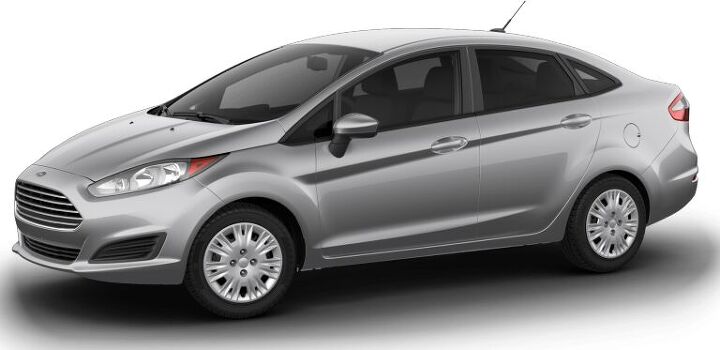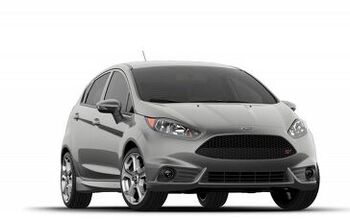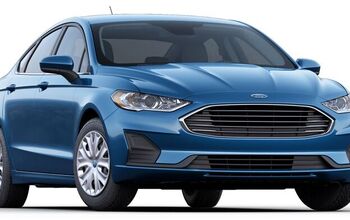Ace of Base: 2019 Ford Fiesta S

One of the advantages when getting rid of (or leaving) something is the propensity to use up supplies on your way out the door. Moving out tomorrow? Better drink all that beer in the fridge. Trading the car in this afternoon? Let’s drive around to burn off the remaining fuel we put in the tank last week.
It would seem the Blue Oval subscribes to this theory as well. With all of its cars headed to the glue factory, some base models have actually gained features while keeping their sticker price steady.
Case in point? The Fiesta S, now with air conditioning.
Stickering at just $14,260, the entry-level Fiesta sedan has picked up a few toys on its way out the door. Gotta use up all that inventory, I guess. Conditioned air is now standard, along with a backup camera and stereo system with six speakers. The unit still looks like Worf’s forehead but at least it includes Bluetooth.
A 1.6-liter inline-four lives under the hood, making 120 horsepower and good for 30 mpg on the combined cycle when hooked to the five-speed manual. Note that the 1.0L has gone away for 2019, not that it would make the Ace of Base grade, anyway. New drivers in places like San Francisco will appreciate the hill-holder function, at least when they’re not dodging homeless people on rechargeable scooters.
The driver’s seat now adjusts six different ways. Paired with a tilt/telescope wheel, all but NBA stars should be able to make themselves comfortable in the driver’s chair of the Fiesta. Not mentioned in the literature but illustrated in pictures (so check for yourself at the dealer) are height-adjustable seatbelts, a comfort feature not found at any price in some expensive new pickups. Windows here are of the crank-‘em variety.
This sedanlet does have a 60/40 folding rear seat, worth noting since base models would sometimes cheap out and deploy a unit that folded as a single piece (100/0, perhaps?) or not at all. Rear seat riders will also find their own climate ducting.
Styling is always subjective, but the Fiesta is kind of, just, there. At least a couple of dramatic character lines break up the side view and it does not have a tragic rear overhang like the woeful Versa sedan, a machine which makes a Beirut taxi look attractive. Sadly, only three colors are on offer in the base model, though you can have any interior shade you want so long as it’s black.
Generally unstated in this series but worth mentioning this time around is the likely presence of rebates as dealers try to shuffle the last of these sedan off their lots. Right now, some markets have a $1,000 incentive on 2019 models. Pair that with its newfound content, and the base Fiesta sings a pretty good farewell song.
[Images: Ford]
Not every base model has aced it. The ones that have? They help make the automotive landscape a lot better. Any others you can think of, B&B? Let us know in the comments. Naturally, feel free to eviscerate our selections.
The model above is shown with American options and is priced in Freedom Dollars. As always, your dealer may sell for less.

Matthew buys, sells, fixes, & races cars. As a human index of auto & auction knowledge, he is fond of making money and offering loud opinions.
More by Matthew Guy
Latest Car Reviews
Read moreLatest Product Reviews
Read moreRecent Comments
- W Conrad I'm not afraid of them, but they aren't needed for everyone or everywhere. Long haul and highway driving sure, but in the city, nope.
- Jalop1991 In a manner similar to PHEV being the correct answer, I declare RPVs to be the correct answer here.We're doing it with certain aircraft; why not with cars on the ground, using hardware and tools like Telsa's "FSD" or GM's "SuperCruise" as the base?Take the local Uber driver out of the car, and put him in a professional centralized environment from where he drives me around. The system and the individual car can have awareness as well as gates, but he's responsible for the driving.Put the tech into my car, and let me buy it as needed. I need someone else to drive me home; hit the button and voila, I've hired a driver for the moment. I don't want to drive 11 hours to my vacation spot; hire the remote pilot for that. When I get there, I have my car and he's still at his normal location, piloting cars for other people.The system would allow for driver rest period, like what's required for truckers, so I might end up with multiple people driving me to the coast. I don't care. And they don't have to be physically with me, therefore they can be way cheaper.Charge taxi-type per-mile rates. For long drives, offer per-trip rates. Offer subscriptions, including miles/hours. Whatever.(And for grins, dress the remote pilots all as Johnnie.)Start this out with big rigs. Take the trucker away from the long haul driving, and let him be there for emergencies and the short haul parts of the trip.And in a manner similar to PHEVs being discredited, I fully expect to be razzed for this brilliant idea (not unlike how Alan Kay wasn't recognized until many many years later for his Dynabook vision).
- B-BodyBuick84 Not afraid of AV's as I highly doubt they will ever be %100 viable for our roads. Stop-and-go downtown city or rush hour highway traffic? I can see that, but otherwise there's simply too many variables. Bad weather conditions, faded road lines or markings, reflective surfaces with glare, etc. There's also the issue of cultural norms. About a decade ago there was actually an online test called 'The Morality Machine' one could do online where you were in control of an AV and choose what action to take when a crash was inevitable. I think something like 2.5 million people across the world participated? For example, do you hit and most likely kill the elderly couple strolling across the crosswalk or crash the vehicle into a cement barrier and almost certainly cause the death of the vehicle occupants? What if it's a parent and child? In N. America 98% of people choose to hit the elderly couple and save themselves while in Asia, the exact opposite happened where 98% choose to hit the parent and child. Why? Cultural differences. Asia puts a lot of emphasis on respecting their elderly while N. America has a culture of 'save/ protect the children'. Are these AV's going to respect that culture? Is a VW Jetta or Buick Envision AV going to have different programming depending on whether it's sold in Canada or Taiwan? how's that going to effect legislation and legal battles when a crash inevitibly does happen? These are the true barriers to mass AV adoption, and in the 10 years since that test came out, there has been zero answers or progress on this matter. So no, I'm not afraid of AV's simply because with the exception of a few specific situations, most avenues are going to prove to be a dead-end for automakers.
- Mike Bradley Autonomous cars were developed in Silicon Valley. For new products there, the standard business plan is to put a barely-functioning product on the market right away and wait for the early-adopter customers to find the flaws. That's exactly what's happened. Detroit's plan is pretty much the opposite, but Detroit isn't developing this product. That's why dealers, for instance, haven't been trained in the cars.
- Dartman https://apnews.com/article/artificial-intelligence-fighter-jets-air-force-6a1100c96a73ca9b7f41cbd6a2753fdaAutonomous/Ai is here now. The question is implementation and acceptance.




































Comments
Join the conversation
Last generation Jetta S. 1.4 liter 5 speed, 32 mpg. A/C, full controls on the wheel, acceptable electronics. $17k. Doesn't feel like a penalty box. Power windows and locks. IRS, even...that last bit disappeared again on the base car. Leased for $180 per month. Seats look cheap but are comfortable, and I'm whiny about seating. The cheap car has pretty much exactly the same parts as the R or TDI and its a fascinating study of how they make the cheap car different in feel over the more luxury or sport intended vehicle. The Jetta is missing some soundproofing and absent AWD it's all about degree. Drove a Sentra once. It hurt.
Ford sucks at making cars. Case Closed.